The History Book Club discussion

This topic is about
The British Are Coming
AMERICAN REVOLUTIONARY WAR
>
SPOTLIGHTED BOOK - THE BRITISH ARE COMING: THE WAR FOR AMERICA, LEXINGTON TO PRINCETON, 1775-1777 (THE REVOLUTION TRILOGY #1) - Week Eight - June 29th - July 5th, 2020 - Chapters Seventeen and Eighteen (pages 403 - 464) Non Spoiler Thread
date newest »
newest »
 newest »
newest »
The Battle of Valcour Island taking place in October 1776 on Lake Champlain where General Carlton, having told London that he intended to become "master of the lakes" before the ice sealed them shut. Towards that end, Carlton finished building his inland fleet, the British force in Canada having grown to 13,000 men. Benedict Arnold seemed to attract attacks on his character and conduct even though he "had a perfect knowledge in maritime affairs," as Gates assured Washington. (page 412, Kindle edition)
Despite repeated requests by Arnold for increased manpower and supplies, assistance wasn't forthcoming. Arnold initially drew the British troops into a position that limited their advantage but many of the American ships were damaged or lost with many casualties. With no choice the American fleet was forced to make a run for Crown Point, forty-five miles south. In the darkness thirteen of the surviving ships slipped past the British under the command of Pringle. However, the British then turned south in pursuit of the Americans, but Arnold knew of Ferris Bay, a small u-shaped cove and then on to Ticonderoga.
Despite repeated requests by Arnold for increased manpower and supplies, assistance wasn't forthcoming. Arnold initially drew the British troops into a position that limited their advantage but many of the American ships were damaged or lost with many casualties. With no choice the American fleet was forced to make a run for Crown Point, forty-five miles south. In the darkness thirteen of the surviving ships slipped past the British under the command of Pringle. However, the British then turned south in pursuit of the Americans, but Arnold knew of Ferris Bay, a small u-shaped cove and then on to Ticonderoga.
Thank you, Bentley. It helps my understanding of the book if I can put it each chapter and subsequent battle in some kind of context. I am really enjoying Atkinson's writing.
message 6:
by
Bentley, Group Founder, Leader, Chief
(last edited Jul 05, 2020 07:10PM)
(new)
-
rated it 4 stars
The chapters are dense; but he gives each chapter a lot of thought and care and he sets up his source work assiduously each time.
The pre background work and how they put their source material together for their research tells you a great deal about the book even before you read it.
Also, says a great deal about their editor.
The pre background work and how they put their source material together for their research tells you a great deal about the book even before you read it.
Also, says a great deal about their editor.
 Finally caught up. I find it interesting that the very year that the Declaration of Independence was put into effect came close to being, if not actually being so, the worst year of the war for the Americans. By the end of the year, with the Northern Army being pushed back to Ticonderoga and the Main Army being ejected from New York its environs, it is a wonder they could hold the armies together. Yet they managed. How might the Battle of New York ended if the French would have entered the fray in 1776. Might make a good alternative history novel to play with what would have happened if the French fleet would have caught the British fleet in the New York Harbor area.
Finally caught up. I find it interesting that the very year that the Declaration of Independence was put into effect came close to being, if not actually being so, the worst year of the war for the Americans. By the end of the year, with the Northern Army being pushed back to Ticonderoga and the Main Army being ejected from New York its environs, it is a wonder they could hold the armies together. Yet they managed. How might the Battle of New York ended if the French would have entered the fray in 1776. Might make a good alternative history novel to play with what would have happened if the French fleet would have caught the British fleet in the New York Harbor area.As we mentioned earlier the lack of a navy put the American cause at a huge disadvantage.
 Regarding Benedict Arnold. Atkinson gives us a glimpse here of his efforts to help the cause. As Lorna pointed out he seems to get blamed or derided for a lot of things that were not necessarily his fault. In the book's description of him it seems he had a very strong personality and great self-assurance which may have caused others to be threatened by him. He may have alienated others with how he approached certain situations. And then, there is always the jealousy factor and the fear that he may surpass someone else in command. It will be interesting to see how Atkinson deals with his story and future decisions.
Regarding Benedict Arnold. Atkinson gives us a glimpse here of his efforts to help the cause. As Lorna pointed out he seems to get blamed or derided for a lot of things that were not necessarily his fault. In the book's description of him it seems he had a very strong personality and great self-assurance which may have caused others to be threatened by him. He may have alienated others with how he approached certain situations. And then, there is always the jealousy factor and the fear that he may surpass someone else in command. It will be interesting to see how Atkinson deals with his story and future decisions.
Hello Michael - yes - the lack of a Navy was a huge deficit. I have to say that it is surprising that the Americans won this war.
Glad that you are catching up.
Glad that you are catching up.
message 10:
by
Bentley, Group Founder, Leader, Chief
(last edited Jul 06, 2020 10:40AM)
(new)
-
rated it 4 stars
Michael, I think that Benedict Arnold was one of the best officers the Americans had; but his personality and aggressiveness turned folks off. You are right I am afraid that his very strong personality which was a big plus for the fledgling American conglomerate - calling it an army is really not apt - seemed too much to bear for those around him. I think they were very jealous of him as you correctly noted.
*Thoughts for conducting the War from the Side of Canada.
By Lieutenant-General Burgoyne.
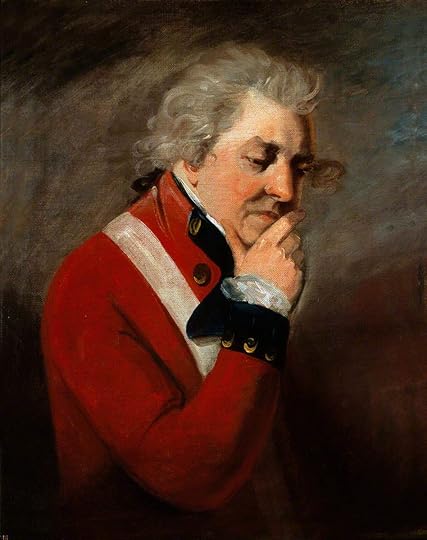
Lieutenant-General John Burgoyne (1722–1792) (a study for a detail of ‘The Funeral of General Simon Fraser, who was shot after the action at Saratoga, October 7, 1777’) John Graham (1755–1817) - National Army Museum
WHEN the last ships came from Quebec, a report prevailed in
Canada, said to have been founded upon positive evidence, that the rebels had laid the keels of several large vessels at Skenesborough andTiconderoga, and were resolved to exert their utmost powers, to constructa new and formidable fleet during the winter.
I will not, however, give credit to their exertions, in such a
degree as to imagine the King's troops will be prevented passing Lake Champlain early in the summer, but will suppose the operations of the army to begin from Crown Point.
But as the present means to form effectual plans is to lay down
every possible difficulty, I will suppose the enemy in great force at
Ticonderoga; the different works there are capable of admitting twelve thousand men.
I will suppose him also to occupy Lake George with a
considerable naval strength, in order to secure his retreat, and
afterwards to retard the campaign; and it is natural to expect that he will take measures to block up the roads from Ticonderoga to Albany by the way of Skenesborough, by fortifying the strong ground at different places, and thereby obliging the King's army to carry a weight of artillery with it, and by felling trees, breaking bridges, and other obvious impediments, to delay, though he should not have power or spirit finally to resist, its progress.
The enemy thus disposed upon the side of Canada, it is to be
considered what troops will be necessary, and what disposition of
them will be most proper to prosecute the campaign with vigour and
effect.
I humbly conceive the operating army (I mean exclusively of the
troops left for the security of Canada) ought not to consist of less
than eight thousand regulars, rank and file. The artillery required in the memorandums of General Carleton, a corps of watermen, two thousand Canadians, including hatchet-men and other workmen, and one thousand or more savages.
It is to be hoped that the reinforcement and the victualling
ships may all be ready to sail from the Channel and from Corke on the last day of March. I am persuaded that to sail with a fleet of
transports earlier, is to subject government to loss and
disappointment. It may reasonably be expected that they will reach Quebec before the 20th of May, a period in full time for opening the campaign. The roads, and the rivers and lakes, by the melting and running off of the snows, are in common years impracticable sooner.
But as the weather long before that time will probably have
admitted of labour in the docks, I will take for granted that the fleet of last year, as well bateaux as armed vessels, will be found repaired,
augmented, and fit for immediate service. The magazines that remain of provision, I believe them not to be abundant, will probably be formed at Montreal, Sorel and Chamblée.
I conceive the first business for those entrusted with
the chief powers, should be to select and post the troops destined to remain in Canada; to throw up the military stores and provision with all possible dispatch, in which service the above mentioned troops, if properly posted, will greatly assist; and to draw the army destined for operation to cantonments, within as few days march of St. John's as conveniently may be. I should prefer cantonments at that season of the year to encampment, as the ground is very damp, and consequently very pernicious to the men, and more especially as they will have been for many months before used to lodgings, heated with stoves, or between decks in ships; all these operations may be put in motion together, but they severally require some observation.
I should wish that the troops left in Canada, supposing
the number mentioned in my former memorandum to be approved, might be made as follows.
Remainder of Burgoynes Memorandum:
https://quod.lib.umich.edu/e/ecco/004...
Source: 18th Century Collections Online
By Lieutenant-General Burgoyne.

Lieutenant-General John Burgoyne (1722–1792) (a study for a detail of ‘The Funeral of General Simon Fraser, who was shot after the action at Saratoga, October 7, 1777’) John Graham (1755–1817) - National Army Museum
WHEN the last ships came from Quebec, a report prevailed in
Canada, said to have been founded upon positive evidence, that the rebels had laid the keels of several large vessels at Skenesborough andTiconderoga, and were resolved to exert their utmost powers, to constructa new and formidable fleet during the winter.
I will not, however, give credit to their exertions, in such a
degree as to imagine the King's troops will be prevented passing Lake Champlain early in the summer, but will suppose the operations of the army to begin from Crown Point.
But as the present means to form effectual plans is to lay down
every possible difficulty, I will suppose the enemy in great force at
Ticonderoga; the different works there are capable of admitting twelve thousand men.
I will suppose him also to occupy Lake George with a
considerable naval strength, in order to secure his retreat, and
afterwards to retard the campaign; and it is natural to expect that he will take measures to block up the roads from Ticonderoga to Albany by the way of Skenesborough, by fortifying the strong ground at different places, and thereby obliging the King's army to carry a weight of artillery with it, and by felling trees, breaking bridges, and other obvious impediments, to delay, though he should not have power or spirit finally to resist, its progress.
The enemy thus disposed upon the side of Canada, it is to be
considered what troops will be necessary, and what disposition of
them will be most proper to prosecute the campaign with vigour and
effect.
I humbly conceive the operating army (I mean exclusively of the
troops left for the security of Canada) ought not to consist of less
than eight thousand regulars, rank and file. The artillery required in the memorandums of General Carleton, a corps of watermen, two thousand Canadians, including hatchet-men and other workmen, and one thousand or more savages.
It is to be hoped that the reinforcement and the victualling
ships may all be ready to sail from the Channel and from Corke on the last day of March. I am persuaded that to sail with a fleet of
transports earlier, is to subject government to loss and
disappointment. It may reasonably be expected that they will reach Quebec before the 20th of May, a period in full time for opening the campaign. The roads, and the rivers and lakes, by the melting and running off of the snows, are in common years impracticable sooner.
But as the weather long before that time will probably have
admitted of labour in the docks, I will take for granted that the fleet of last year, as well bateaux as armed vessels, will be found repaired,
augmented, and fit for immediate service. The magazines that remain of provision, I believe them not to be abundant, will probably be formed at Montreal, Sorel and Chamblée.
I conceive the first business for those entrusted with
the chief powers, should be to select and post the troops destined to remain in Canada; to throw up the military stores and provision with all possible dispatch, in which service the above mentioned troops, if properly posted, will greatly assist; and to draw the army destined for operation to cantonments, within as few days march of St. John's as conveniently may be. I should prefer cantonments at that season of the year to encampment, as the ground is very damp, and consequently very pernicious to the men, and more especially as they will have been for many months before used to lodgings, heated with stoves, or between decks in ships; all these operations may be put in motion together, but they severally require some observation.
I should wish that the troops left in Canada, supposing
the number mentioned in my former memorandum to be approved, might be made as follows.
Remainder of Burgoynes Memorandum:
https://quod.lib.umich.edu/e/ecco/004...
Source: 18th Century Collections Online
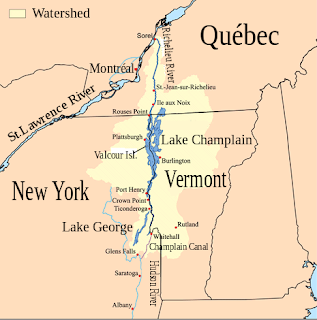
Lake Champlain Region (from Wikimedia)

American Fleet on Lake Champlain - rather paltry looking compared to British Royal Navy at the time
Episode 106: Arms Race at Lake Champlain
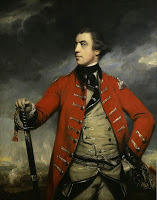
General Burgoyne (from Wikimedia
Link to Biography:
http://www.biographi.ca/en/bio/burgoy...
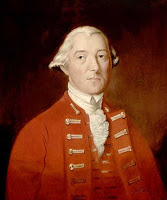
General Sir Guy Carleton from Wikimedia
Link to Biography: http://www.biographi.ca/en/bio/carlet...
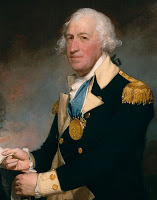
General Horatio Gates

General Benedict Arnold
Text from Podcast:
Today, I’m going to step away from New York City to take a look at events on Lake Champlain. At the same time the Howe Brothers in New York were using their massive military force to push Washington out of New York, Generals Guy Carleton and John Burgoyne were trying to push southward from Canada. We last looked at Canada in Episode 95 when Carleton’s troops pushed the last of the Continental Army out of Canada and into Lake Champlain in upstate New York. The remains of the Patriot’s Northern Army fell back to Fort Ticonderoga.
Carleton and Burgoyne
For the British in Canada, everything seemed to be going well during the spring. Burgoyne had a late arrival in May 1776. By the end of June, the British had pushed the Americans out of Canada entirely. Burgoyne had used the 8000 or so British and German forces he had brought with him from Britain. With the combined local militia and Indians he had a force of 11,000-12,000 men.
Following the victory in Canada, Carleton and Burgoyne’s disagreement became more apparent. Clearly, according to rank and Lord Germain’s express orders, Carleton retained command. Burgoyne would obey orders but as most top subordinates did at the time, made clear to anyone who would listen that Carlton was holding him back. He could lead the forces to victory if only Carlton did not hold his reins so tightly.
Burgoyne had left Boston in the fall of 1775 to return home and convince the King and ministry that he knew how to win the war. He drafted a memo for the ministry entitled: Thoughts for Conducting the War from the Side of Canada. He planned to lead his military force up the St. Lawrence River to break the siege of Quebec and free Gen. Carleton. From there, his men would move down lake Champlain to retake Fort Ticonderoga. Next, they would move down the Hudson River, eventually linking up with Howe’s Army moving up the river from New York City. He even made a bet with a friend in London that he would be back, victorious, by Christmas 1777.
There was nothing particularly new about this plan. The Ministry had been planning to use the Hudson River to cut off New England since the war began. Burgoyne’s memo added far more details on exactly what troops should be used and why. That was essentially what the ministry adopted as its plan, but with one alteration. General Carleton, not Burgoyne, would command the army after it reached Quebec.
Gen. Carleton could not easily move his British fleet on the St. Lawrence River to Lake Champlain. He would have to disassemble his ships, carry them up the rapids, and then reassemble them at St. Jean before he could sail into the Lake, or in the alternative, build new ships at St. Jean and carry over the armaments needed. Either option would take months.
Remainder of podcast text:
http://blog.amrevpodcast.com/2019/07/...
Sources for above: American Revolution Podcast, Dictionary of Canadian Biography, Wikipedia, Wikimedia

General Burgoyne (from Wikimedia
Link to Biography:
http://www.biographi.ca/en/bio/burgoy...

General Sir Guy Carleton from Wikimedia
Link to Biography: http://www.biographi.ca/en/bio/carlet...

General Horatio Gates

General Benedict Arnold
Text from Podcast:
Today, I’m going to step away from New York City to take a look at events on Lake Champlain. At the same time the Howe Brothers in New York were using their massive military force to push Washington out of New York, Generals Guy Carleton and John Burgoyne were trying to push southward from Canada. We last looked at Canada in Episode 95 when Carleton’s troops pushed the last of the Continental Army out of Canada and into Lake Champlain in upstate New York. The remains of the Patriot’s Northern Army fell back to Fort Ticonderoga.
Carleton and Burgoyne
For the British in Canada, everything seemed to be going well during the spring. Burgoyne had a late arrival in May 1776. By the end of June, the British had pushed the Americans out of Canada entirely. Burgoyne had used the 8000 or so British and German forces he had brought with him from Britain. With the combined local militia and Indians he had a force of 11,000-12,000 men.
Following the victory in Canada, Carleton and Burgoyne’s disagreement became more apparent. Clearly, according to rank and Lord Germain’s express orders, Carleton retained command. Burgoyne would obey orders but as most top subordinates did at the time, made clear to anyone who would listen that Carlton was holding him back. He could lead the forces to victory if only Carlton did not hold his reins so tightly.
Burgoyne had left Boston in the fall of 1775 to return home and convince the King and ministry that he knew how to win the war. He drafted a memo for the ministry entitled: Thoughts for Conducting the War from the Side of Canada. He planned to lead his military force up the St. Lawrence River to break the siege of Quebec and free Gen. Carleton. From there, his men would move down lake Champlain to retake Fort Ticonderoga. Next, they would move down the Hudson River, eventually linking up with Howe’s Army moving up the river from New York City. He even made a bet with a friend in London that he would be back, victorious, by Christmas 1777.
There was nothing particularly new about this plan. The Ministry had been planning to use the Hudson River to cut off New England since the war began. Burgoyne’s memo added far more details on exactly what troops should be used and why. That was essentially what the ministry adopted as its plan, but with one alteration. General Carleton, not Burgoyne, would command the army after it reached Quebec.
Gen. Carleton could not easily move his British fleet on the St. Lawrence River to Lake Champlain. He would have to disassemble his ships, carry them up the rapids, and then reassemble them at St. Jean before he could sail into the Lake, or in the alternative, build new ships at St. Jean and carry over the armaments needed. Either option would take months.
Remainder of podcast text:
http://blog.amrevpodcast.com/2019/07/...
Sources for above: American Revolution Podcast, Dictionary of Canadian Biography, Wikipedia, Wikimedia
message 16:
by
Bentley, Group Founder, Leader, Chief
(last edited Jul 12, 2020 11:47AM)
(new)
-
rated it 4 stars
No you are not!!!! For whatever reason, it fell off the folder. I will resurrect it and I have opened up next week's thread. The numbering for the weeks was perfect - you are correct when I looked to check - Week Eight was there and Week Ten which I opened early.
I will put again put up Week Nine and add to it again.
I will put again put up Week Nine and add to it again.
The Week Eight reading assignment is:
Week Eight: -(June 29th - July 5th) (pages 403 - 464)
Part Three - page 403
Chapter 17. MASTER OF THE LAKES Lake Champlain, October 1776 - page 405
Chapter 18. THE RETROGRADE MOTION OF THINGS New York, October–November 1776 - page 431
Week Eight: -(June 29th - July 5th) (pages 403 - 464)
Part Three - page 403
Chapter 17. MASTER OF THE LAKES Lake Champlain, October 1776 - page 405
Chapter 18. THE RETROGRADE MOTION OF THINGS New York, October–November 1776 - page 431
Chapter Overviews and Summaries:
Part Three
Chapter 17. MASTER OF THE LAKES
Lake Champlain
October 1776
Chapter 18. THE RETROGRADE MOTION OF THINGS New York
October–November 1776
Part Three
Chapter 17. MASTER OF THE LAKES
Lake Champlain
October 1776
Chapter 18. THE RETROGRADE MOTION OF THINGS New York
October–November 1776
message 23:
by
Bentley, Group Founder, Leader, Chief
(last edited Jul 16, 2020 12:45AM)
(new)
-
rated it 4 stars
We have completed this week's reading - once you have completed posting on this assignment - please go to the next thread Week Nine.
Link to the Week Nine Thread:
https://www.goodreads.com/topic/show/...
Link to the Week Nine Thread:
https://www.goodreads.com/topic/show/...




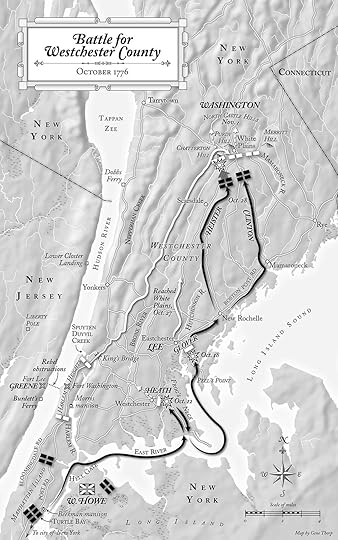
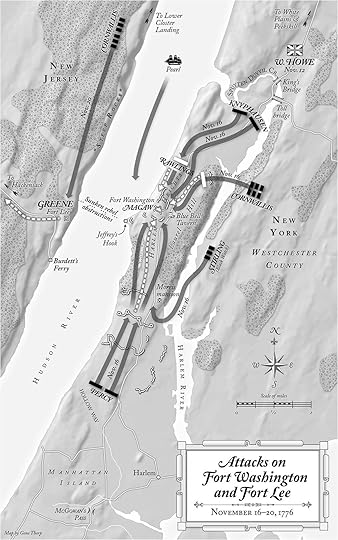


Rick Atkinson.
Hello Everyone,
For the week of June 29th - July 5th, we are reading Chapter Seventeen and Chapter Eighteen/b>.
The Week Eight reading assignment is:
Week Eight: -(June 29th - July 5th) (pages 403 - 464)
Part Three - page 403
Chapter 17. MASTER OF THE LAKES Lake Champlain, October 1776 - page 405
Chapter 18. THE RETROGRADE MOTION OF THINGS New York, October–November 1776 - page 431
We will open up a thread for each week's reading. Please make sure to post in the particular thread dedicated to those specific chapters and page numbers to avoid spoilers. We will also open up supplemental threads as we did for other spotlighted books.
This book was kicked off May 10th
We look forward to your participation. Amazon, Barnes and Noble, other noted on line booksellers do have copies of the book and shipment can be expedited. The book can also be obtained easily at your local library, or on your Kindle.
There is no rush and we are thrilled to have you join us. It is never too late to get started and/or to post.
Bentley will be moderating this selection. And Lorna will be my backup.
Welcome,
~Bentley
TO ALWAYS SEE ALL WEEKS' THREADS SELECT VIEW ALL
REMEMBER NO SPOILERS ON THE WEEKLY NON SPOILER THREADS - ON EACH WEEKLY NON SPOILER THREAD - WE ONLY DISCUSS THE PAGES ASSIGNED OR THE PAGES WHICH WERE COVERED IN PREVIOUS WEEKS. IF YOU GO AHEAD OR WANT TO ENGAGE IN MORE EXPANSIVE DISCUSSION - POST THOSE COMMENTS IN ONE OF THE SPOILER THREADS. THESE CHAPTERS HAVE A LOT OF INFORMATION SO WHEN IN DOUBT CHECK WITH THE CHAPTER OVERVIEW AND SUMMARY TO RECALL WHETHER YOUR COMMENTS ARE ASSIGNMENT SPECIFIC. EXAMPLES OF SPOILER THREADS ARE THE GLOSSARY, THE BIBLIOGRAPHY, THE INTRODUCTION AND THE BOOK AS A WHOLE THREADS.
Notes:
It is always a tremendous help when you quote specifically from the book itself and reference the chapter and page numbers when responding. The text itself helps folks know what you are referencing and makes things clear.
Citations:
If an author or book is mentioned other than the book and author being discussed, citations must be included according to our guidelines. Also, when citing other sources, please provide credit where credit is due and/or the link. There is no need to re-cite the author and the book we are discussing however.
Here is the link to the thread titled Mechanics of the Board which will help you with the citations and how to do them.
http://www.goodreads.com/topic/show/2...
Also, the citation thread: (for Unreasonable Men - look at examples)
https://www.goodreads.com/topic/show/...
Introduction Thread:
https://www.goodreads.com/topic/show/...
Table of Contents and Syllabus
https://www.goodreads.com/topic/show/...
Glossary
Remember there is a glossary thread where ancillary information is placed by the moderator. This is also a thread where additional information can be placed by the group members regarding the subject matter being discussed. In the case of this book we have two glossaries which are brought over from other selections (same timeframe) that we will add to.
Here are the links:
https://www.goodreads.com/topic/show/...
https://www.goodreads.com/topic/show/...
Bibliography
There is a Bibliography where books cited in the text are posted with proper citations and reviews. We also post the books that the author may have used in his research or in his notes. Please also feel free to add to the Bibliography thread any related books, etc with proper citations or other books either non fiction or historical fiction that relate to the subject matter of the book itself. In the case of this book, Rick Atkinson's primary sources start on page 703.
No self promotion, please.
Here is the link:
https://www.goodreads.com/topic/show/...
Book as a Whole and Final Thoughts - Spoiler Thread
Here is the link:
https://www.goodreads.com/topic/show/...